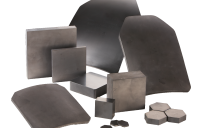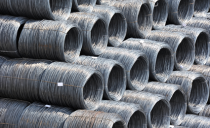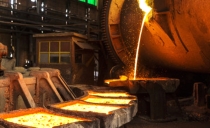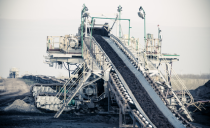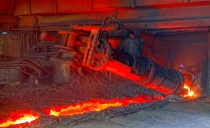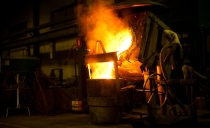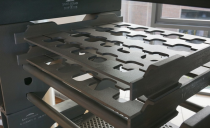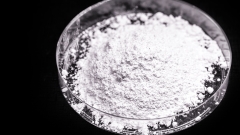
Understanding the Different Al2O3 Bonding Types
Aluminum oxide (Al2O3) is the most commonly occurring of the aluminum oxides. Often called alpha-alumina (or corundum in crystalline form), it is a white, odorless granular substance — slightly finer than table salt — mined from bauxite ore. Although alpha-alumina is not the only crystalline form of aluminum oxide, it is the most common.
Owing to its superior strength, hardness, stiffness, thermal conductivity, high melting point, and resistance to corrosion, is widely used in industry. It can be fabricated using a blend of bonding and forming techniques (including casting and pressing) and modulated using a range of additives and components.
Saint-Gobain High-Performance Ceramics & Refractories have decades of experience in engineering high-performance technical ceramics. Al2O3 engineering materials lend themselves effectively to the most demanding industrial applications.
Chemical Structure of Al2O3
Alpha-crystalline Al2O3 displays a hexagonal closed packing structure (HCP) formed of Al3+ and O2- ions. Each Al3+ ion is surrounded by six O2- ions. The larger-sized O2- ions occupy octahedral voids while the smaller Al3+ ions occupy tetrahedral voids, altogether occupying 74% of the interstitial space, leaving the remainder empty.
Besides the hexagonal α-phase, other metastable phases of Al2O3 include the hexagonal χ-phase, the cubic η- and γ-phases, and the orthorhombic κ-phase.
Chemical Bonding Types of Al2O3
Within an atom, valence electrons — which are found in the outer (or valence) shell — are responsible for forming energetically stable bonds between atoms of the same or different element. There are two basic types of chemical bonds (and a third hybrid type), namely:
Covalent Bonds
Covalent bonds are formed between two neutrally charged atoms, sharing one or more of their valence electrons. These bonds are predominantly formed between nonmetals, although they can be formed between metals and nonmetals as well. Where atoms are of the same element, valence electrons are equally shared. Otherwise, electrons are drawn towards the element with the highest electronegativity, thus forming polar covalent bonds. Covalent compounds generally have a lower melting point when compared to ionic bonds.
Ionic Bonds
In ionic bonding, the outer valence electrons of one atom are completely absorbed into the outer shell of a neighboring atom. This creates a charge imbalance, where the receiving atom becomes negatively charged (anion) and the donor atom becomes positively charged (cation). This type of bonding occurs between metals and nonmetals because metals have few electrons in their outer shells, and they tend to lose them to nonmetals in order to achieve a noble gas configuration.
Metallic Bonds
Metallic bonds behave as a hybrid of covalent and ionic bonds. They occur only between metallic atoms. These atoms form molecular orbitals by sharing their valence electrons, much like in covalent bonding. The difference being that each atom shares its molecular orbitals with every other atom in the lattice. This results in a “bulk” of metal atoms (positive atomic nuclei plus inner electron shells) and a “sea” of valence electrons which are free-flowing and no longer attached to a particular atom. However, because these valence electrons remain within the overall lattice structure, atomic nuclei remain as atoms and do not become positively charged ions.
Properties of Al2O3
Aluminum oxide is an ionic compound formed from an electrostatic bond between two aluminum atoms which have lost 3 electrons each (Al3+) and three oxygen atoms which have gained 2 electrons each (O2-). The strength of the ionic lattice is a function of the individual ionic charges and their radii.
As differences in electronegativity decrease, the bonding becomes increasingly covalent, progressing as follows: From pure ionic, to ionic with covalent character, then polarized covalent, and finally pure covalent.
The stronger the chemical bonds, the higher the melting points. Covalent substances, which behave as molecules, have a low melting point. Structures with double charged ions — such as Al2O3 — have significantly higher melting points as compared to structures of singly charged ions. Ionic compounds have:
- High melting points, which are unaffected by external air pressure and may be lowered with the addition of impurities.
- High boiling points.
- A crystal lattice structure.
- Good insulation characteristics.
Al2O3 is an amphoteric compound, meaning it acts both as a base and an acid. It is also water insoluble. Other properties of Al2O3 include:
- Melting point of 2,072 °C
- Boiling point of 2,977 °C
- Density of between 3.95 g/cm3 and 4.1 g/cm3
- High thermal conductivity (35 W/mK)
Applications of Al2O3
Al2O3 is most commonly used in the production of aluminum metal — In 2021, alumina production totaled 141 million metric tons. As aluminum bonds with oxygen, it creates a thin coating of alumina, which protects the aluminum from corrosion. The thickness of this layer can be engineered through anodization. Major uses of alumina include:
- Engineering ceramics: Due to its superior strength, stiffness, thermal conductivity, and resistance to corrosion, Al2O3 is used in the design of architectural and aerospace structures, industrial and machining tools, refractory linings, high-temperature insulators, ballistic body armor, and more.
- Bionic implants, including pacemakers, bionic eyes and ears.
- Bioengineered hip joints, dental pieces, and tissue scaffolds.
- Plastic fillers, polishing agents and abrasives.
- Paper and textile manufacturing, food processing, and more.
Al2O3 Advanced Materials from Saint-Gobain
With substantial expertise in technical ceramics, Saint-Gobain High-Performance Ceramics & Refractories manufacture an extensive range of Al2O3 engineering materials for the most demanding industrial applications. These materials are highly tailored to fulfill high-performance engineering requirements.
Related content
Armor
Saint-Gobain Performance Ceramics & Refractories is a world-leader in the delivery of innovative, reliable and consistent ceramics for composite armor...
Primary Copper
Discover Saint-Gobain Performance Ceramics & Refractories’ custom engineered solutions for flash melter applications.
Wear Resistant Technologies
Saint-Gobain Performance Ceramics and Refractories have developed a range of wear resistant technologies using alumina oxides (Al2O3 and ZTA) as well as...
Ironmaking - Industries
Discover Saint-Gobain Performance Ceramics & Refractories’ range of ironmaking refractories - improved investment benefits, technical support, material...
Foundry Industries
Saint-Gobain Performance Ceramics & Refractories leverages its extensive expertise to provide innovative, reliable refractory solutions for all ferrous and...
Systems for Kilns & Furnaces
Discover Saint-Gobain Performance Ceramics & Refractories’ comprehensive range of ceramic products and solutions - designed, developed, and manufactured...
Carbon Black
Discover Saint-Gobain Performance Ceramics & Refractories’ comprehensive range of carbon black refractory solutions for tread and carcass reactors.
Petrochemistry, Syngas and Hydrogen
Saint-Gobain Performance Ceramics & Refractories offers unparalleled refractory lining design, engineering, products and services to the global...
